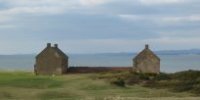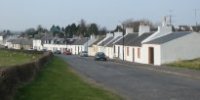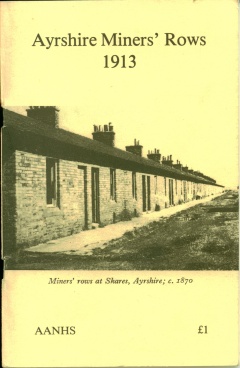 |
 |
 |
 |
Ayrshire Miners' Rows 1913 |
 |
Copyright notice: Links to this site are welcomed. However none of the material on the site may be duplicated in any form. The copyright of the articles is the property of the authors. Copyright of the web pages is the property of David McClure. |
The complete text (without the sketch map) is available in pdf format. Download a pdf file (635KB). |
Ayrshire Miners' Rows
1913

Ayrshire Collections Volume Thirteen Number One
Evidence submitted to the Royal Commission on Housing (Scotland )
by
THOMAS McKERRELL and JAMES BROWN
for the Ayrshire Miners' Union
With notes by JOHN STRAWHORN MA PhD FEIS
AYRSHIRE ARCHAEOLOGICAL AND NATURAL HISTORY SOCIETY 1979
DIGITAL EDITION 2004
Photo caption:
Miners' Rows at Skares, Ayrshire, c.1870
NOTES ON THE DIGITAL EDITION 2004
This is not a facsimile edition and no attempt has been made to reproduce the fonts and pagination of the original. However all of the text of the original has been transcribed and, other than as noted below, follows the same order.
The beginning of each page in the original is shown in this by placing the page number within square brackets: [1], [2], etc.
In the 1979 edition brief notes on the subject matter appeared in the outside margins. Here these notes have been rendered as subheadings. The body of the work has been divided into six sections.
A POSTSCRIPT TO THE FACSIMILE
One of the most sensational advances of the 20th century has been the improvement of housing. According to the 1901 Census, more than half Ayrshire's people lived in homes of only one or two rooms. 9,936 families (19%) were in single-ends, 21,502 (41 %) in two-roomed dwellings. There was a legacy of small overcrowded but-and-bens in the old weaving towns and villages, and even more cramped accommodation in the mining communities. In the coal parishes of Dalmellington, Auchinleck, New Cumnock. Tarbolton, Dalry, and Kilwinning over a quarter were living in single apartments, while in Galston the figure was a lamentable 37%.
The squalor and indignities suggested by these statistics are brought vividly into focus by the Ayrshire Miners Union report which is here reproduced in facsimile.
Ayrshire had 14,000 coal miners producing 4 million tons annually - for household use; for factories; for the blast furnaces of Glengarnock, Kilwinning, Stevenston, Waterside, Lugar and Muirkirk; for the locomotives of the Glasgow and South Western Railway; and for export to Ireland through Ardrossan, Troon, and Ayr. The compact north Ayrshire coalfield had been extensively mined for over a century by numerous small companies, and was approaching exhaustion. Certain areas of the wide but more difficult central Ayrshire field had also been exploited, especially by William Baird the ironmaster; and the deeper seams were being worked after the sinking of the Barony Pit near Auchinleck in 1906.
In north Ayrshire the pitheads and the miners rows were sited near busy manufacturing centres It was quite different in central Ayrshire. Many of the pits were sunk well away from towns and villages; and separate mining communities, some of them sizeable, had grown up, often in remote upland moors.
Some of the miners rows were stone built and around a century old; the newer ones were of brick. A few were thatched, most were slated, several had roof coverings of tar cloth. Most were single-storey, sometimes forming squares, but the usual plan was a series of parallel rows of connected dwellings. In a few places houses were built back-to-back. Of the houses listed - there are no reports for several places like Whitletts - 27% were single-ends, sometimes as small as 12 feet square. In one such at Drongan nine persons had their home. Set-in beds were supplemented by hurleys (see page 32). Crowded conditions were normal; subsidence and disrepair common; facilities primitive. Half the rows were without coal houses - so fuel had to be stored on the bare earth under the set-in beds. Even more rows were without wash houses - so clothes (and miners) had to be washed in tin tubs indoors on the brick tile floors. Several families had to share the outdoor earth closets - while at Burnfoothill, a community of over a thousand souls, there were no closets of any kind. Fortunately most of the rows had a good supply of piped water, obtainable from the streetside 'wells'.
Only at Dalmellington, Mossblown, and New Cumnock did the reporters find some newly-built houses of [4] tolerable standards. And the human spirit will always triumph against adversity. At one typical miners village, Skares, the Cumnock Chronicle tells us there were three friendly societies (Gardeners, Rechabites, Good Templars), a quoiting club, an ambulance corps, a juvenile football club, a brass band, a dramatic society, and a phonetics class.
To combat the coalmasters who controlled
the pits, houses, and often the only shops serving the rows,
the Ayrshire Miners Union had been formed in 1886 with James
Keir Hardie as organising secretary. Turning to political
action, Hardie helped form the Independent Labour Party in
1893, and was elected M.P. for West Ham (1892-1895) and Merthyr
(1900-1915). A parliamentary Labour Party emerged with 29
members (1906 Election) and 40 (1910) - though only three
of this latter number came from Scottish seats. Nevertheless
the Liberal Government was committed to a policy of social
reform, involving among other things the appointment of a
Royal Commission on Housing in
The First World War postponed the completion of the Royal Commission's work: thereafter a sequence of acts of parliaments facilitated the expansion of local authority housing. Also, in 1918 James Brown from Annbank, one of the two authors of this report, won South Ayrshire for the Labour Party, and remained the member for that constituency during 1918-1931 and 1935-1939.
But the miners rows continued long in use. In the inter-war period scarcity of public money hindered the massive tasks of slum clearance and reduction of overcrowding; and during and immediately after the Second World War building was virtually halted. In the generation between 1919 and 1948 the Ayrshire local authorities were able to build 25,000 new houses. In the following twenty years another 46,000 were added. It was in this period - near a half-century after this Report was compiled - that the miners rows were demolished. Annbank and Drongan were rebuilt. But the remoter sites were abandoned and the residents offered new houses in more convenient centres - New Cumnock, Logan and Netherthird by Cumnock, Auchinleck, Ochiltree, Mauchline, Tarbolton, Patna, and Dalmellington.
For the opportunity of publishing in facsimile this historic social document, we are indebted for a loan of an original copy to A. N. (Sandy) Fielding, then a young lad in Drongan, and at the time of writing a still-lively octogenarian retired to Maybole.
February 1979 JOHN STRAWHORN
Articles on the history of Ayrshire mining have appeared in previous issues of the Ayrshire Collections: Vols. 1 (1950), 4 (1958), 5 (1959), 6 (1961), 7 (1966), 8 (1969), 10 (1972); as well as in John Strawhorn's Ayrshire: The Story of A County, (1975), also published by the Ayrshire Archaeological and Natural History Society.
Go to sketch map of The Ayrshire Coalfield